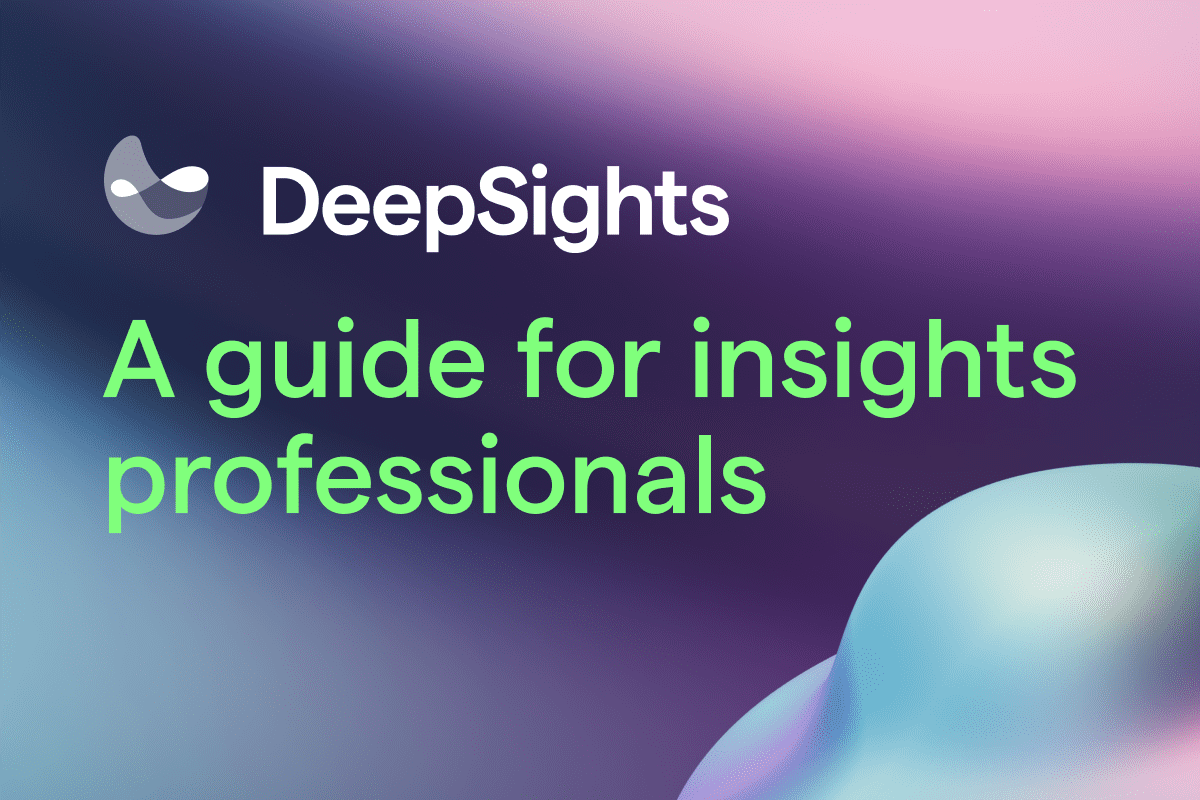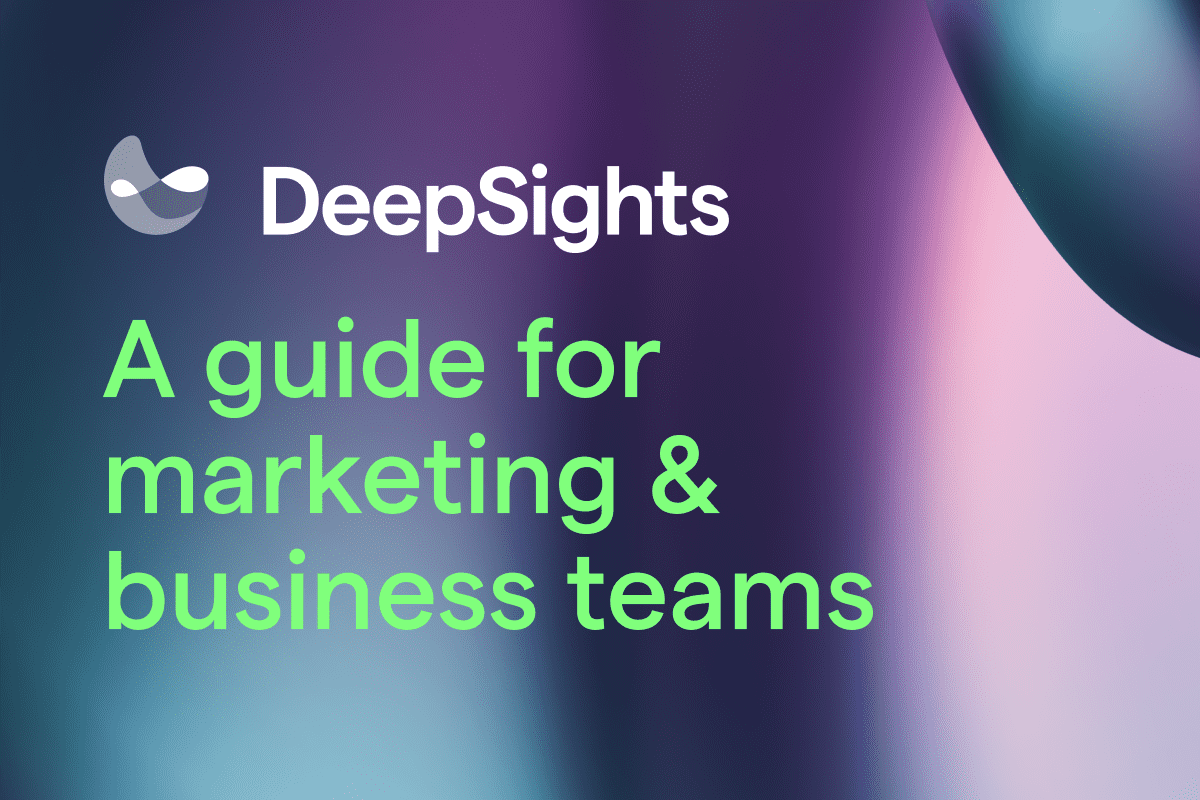For insights teams it can be frustrating when the hard work put into discovering important customer insights goes unused in business decisions. It can happen for a number of reasons, but when it happens repeatedly, you might start to feel like you’re stuck in the tactical details of executing research instead of helping the business make better, consumer insights-driven decisions.
Why it’s time to reposition your customer insights team as a strategic asset
In today’s fast-paced, data-driven landscape, customer insights are no longer just a support function—they are a critical driver of strategic decision-making. When insights teams are empowered to shape direction rather than simply inform it, they unlock value across innovation, marketing, and customer experience. By repositioning the insights function as a strategic asset, organizations can stay ahead of market shifts and deeply align with evolving consumer needs.
So how can your insights function become a trusted pivotal partner to the business — where you have a seat at the table and your insights are put into action? Insights experts Elias Soussou, Senior Director, Global Consumer & Market Insights at FGX International, Soumya Nair, Global Insights Director at Kerry, and Joseph Rini, Senior Commercial Product Manager at Market Logic, with Richard Kelly, Chief Strategy Officer at Fuel Cycle, moderating, dove into this topic in a recent TMRE @ Home panel discussion called “From support staff to pivotal partner: advancing the role of insights.”
Below, we draw from that conversation to look at five ways to enhance and optimize the tactical work of research management, with the support of insights AI technology. Each point includes a scenario detailing how insights AI can help free up time to nurture high-value strategic work with your stakeholders — so you can elevate the value of insights across your organization.
Five ways your insights team can unlock strategic impact at every stage of the insights lifecycle

1. Collaborate across teams to build better research briefs and stronger cross-team alignment
Collaborate with your stakeholders during the research planning phase. This step helps to elevate the role of insights by building trust between insights and business teams and ensuring the research vision is clear.
In these strategic conversations, you, the insights professional, can take the role of an internal business consultant. Ensure the research not only addresses the needs of the business unit or campaign but it also aligns with the organization’s strategic pillars to keep it relevant in the bigger picture.
As Elias pointed out during the panel, ask the tough questions here: push to understand how the research will be used and what decisions are going to be made based on that research. By clarifying the strategic vision and purpose for the research in a collaborative way, you nurture your relationship with business stakeholders.
Doing this can help the stakeholders better understand and trust insights once they’re delivered — making them more likely to translate into impactful decisions, and positioning the insights function in more of an advisor role.
Use case: Get instant insights during strategic conversations
Imagine you’re collaborating with a business stakeholder on a new research brief. You pull up your insights platform’s AI-assisted research management suite and start crafting your brief together. As soon as you start typing your discussion points into the platform’s research brief field, it immediately brings up all your past research on the topic. This means you and your stakeholder instantly see your organization’s existing knowledge, and those insights steer your discussion to avoid duplicating research you don’t need.
But you also want to have a healthy discussion that considers conflicting data or counterpoints to the sales story the business has in mind — this will help you and your stakeholder foresee obstacles that may come up in the research and refine the brief accordingly. You pull up your AI insights assistant and get instant answers to your business questions that challenge the status quo. This further steers your conversation towards a precise brief that considers all sides of the story before you jump into the research.
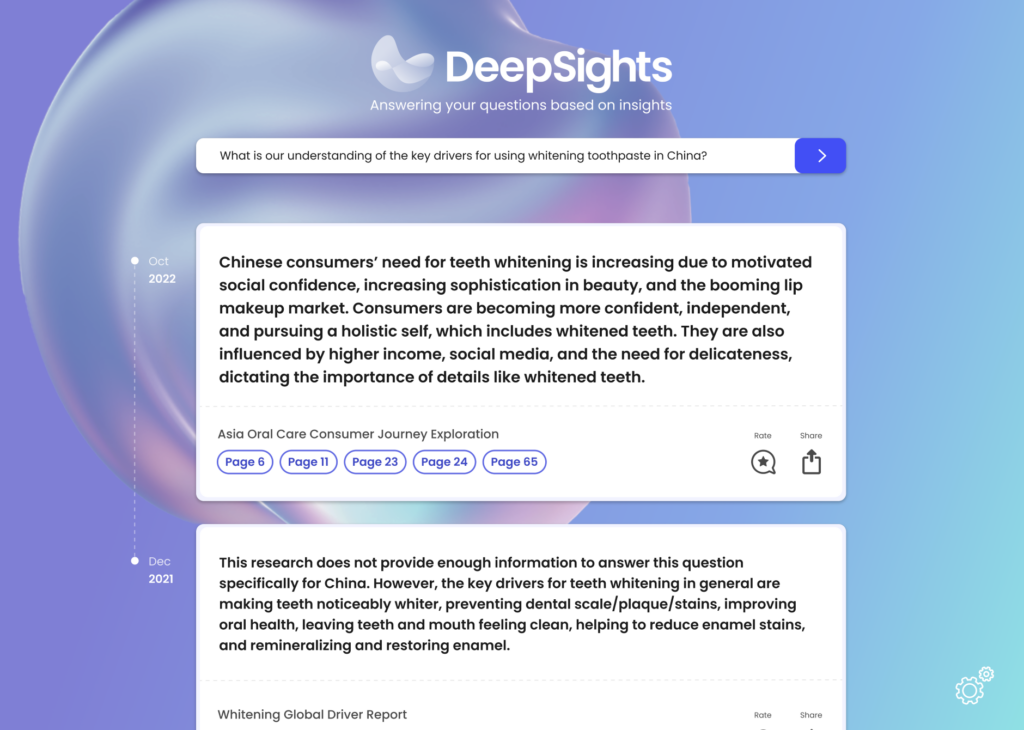
2. Partner with research vendors who help your insights team drive business impact
The panel agreed that your research vendors significantly impact your ability to step into an advisor role. It’s crucial to choose partners who do more than just deliver reports — they weave a compelling research story your organization can easily understand and act on. They provide context and interpretation that bridges the gap between their findings and actionable insights your decision-makers can actually use.
Create a roster of vetted research vendors whose quality work gives you more time for strategic conversations with stakeholders. The right partner becomes extremely crucial in showcasing the value of insights inside your organization, and your ability to have strategic influence over how insights are used.
Use case: Streamline vendor management with insights management technology
You may have research partners all over the world servicing unique projects for unique geographies — all with their preferred vendors. It can be hard to keep track and ensure your organization is consistent in their use of your top-tier vendors.
Streamline your research management by ensuring only approved agencies conduct research in categories you specify and within budgets you set. Plus, you can ensure all your research vendors upload research results to one place.
3. Empower cross-functional teams to self-serve insights and reduce bottleneck
As an insights professional, you’re expected to manage both small-scale, transactional insights requests and large-scale, strategic projects while delivering business impact in both. It’s challenging because you need to focus more on the latter to elevate your role to strategic partner, but neglecting the tactical aspects of insights and research management doesn’t solve your problem either.

If you serve both arenas consistently, stakeholders at all levels can trust your insights function to reliably deliver value. It’s important to gain more followers or insights “customers” within your organization — enhanced visibility and broad support is necessary to achieve your role as an indispensable advisor to the business.
The problem is that insights teams are resource-constrained, which can make it difficult to focus on both insights support and nurturing the insights function’s strategic role. This is where empowering the business to self-serve insights is crucial to enhancing your support work while freeing up resources for stakeholder relationship-building, strategic conversations, and translating insights to business impact.
Lighten your load with self-service insights
Liberate your insights function from repeatedly sifting through overwhelming knowledge assets and datasets to answer reactive business questions. Leverage AI-powered 24/7 self-service access to insights you trust, so you can maximize your impact.
Empower stakeholders and insights pros alike to ask questions directly in collaboration tools like Microsoft teams, email, and Google Chat and immediately surface to the most relevant, reliable data and get insights reports with a single click. Eliminate the need for training by leveraging generative AI technology, and stay in control with adaptable user permissions and customizable interactions that fit your organizational norms.
4. Tie insights reporting to strategic goals to elevate your behavioral insights team
At the reporting stage of the insights lifecycle, it’s crucial that you take the time to tie research outcomes back to your strategy and original brief. Sharing knowledge and insights after the research ends is just as important as the research itself. It’s an opportunity for you to take off your researcher hat and step into the insights-advisor role, so you can demonstrate the relevance and value of those insights within the strategic context of the business — and remind stakeholders of how to use those insights for real business impact.
Accelerate reporting so you can focus on strategic alignment
Give yourself more time to emphasize the relevance and impact of new insights. There’s powerful new AI technology, trained and tailored for insights, that you can trust and use to support you effectively in the reporting phase.
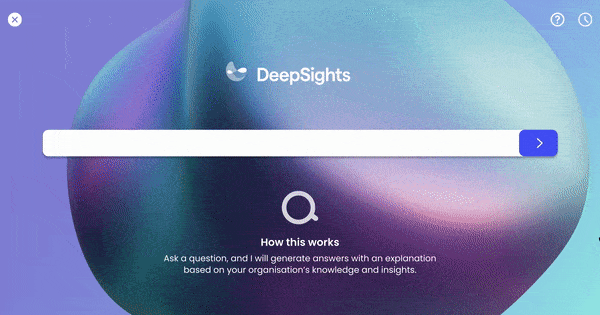
Leverage it to rapidly generate reports and high-level summaries, so you can focus on supporting strategic decision-making that gets right to the heart of your business strategy.
5. Repurpose unused research to increase your insights team’s long-term value
It can be discouraging when your insights receive a lukewarm response and decision-makers don’t end up using them in key decisions. But there are ways you can make sure your research retains value long after a project is completed.
First, make it a priority to understand why the insights weren’t used. Empathize with and understand your stakeholders’ needs and perspectives, so you’re prepared to communicate insights more clearly and strategically in the future.
Then, as Soumya mentioned during the panel, remember that insights that may seem irrelevant now may become critical in the future due to changes in market conditions, consumer behavior, or business strategy. Insights teams should be prepared to re-introduce previous research at strategic moments.
At the same time, make sure you communicate new insights at scale, so different business units can benefit from and find relevance in research conducted for different purposes. And keep in mind that when insights seem to conflict with current strategies or understandings, it’s even more crucial to frame them within the larger business context, demonstrating their potential to inform future strategies or to resolve existing contradictions.
For instance, a study initially conducted to understand consumer preferences for a new product may end up providing insights into broader market trends or customer behaviors. When you identify multiple uses for insights and share these possibilities across the business, insights professionals can demonstrate the versatile value of their work, encourage broader engagement, and reduce the likelihood of research being overlooked or collecting dust on a shelf.
Create high-value content from 100% of your knowledge assets
Leverage AI to amalgamate diverse data and knowledge into an advanced knowledge bank that you can easily curate and continually update. Boost insights visibility and influence business decisions with AI-assisted curated newsletters and dedicated areas where insights on specific topics are easily maintained, updated, and accessible 24/7.
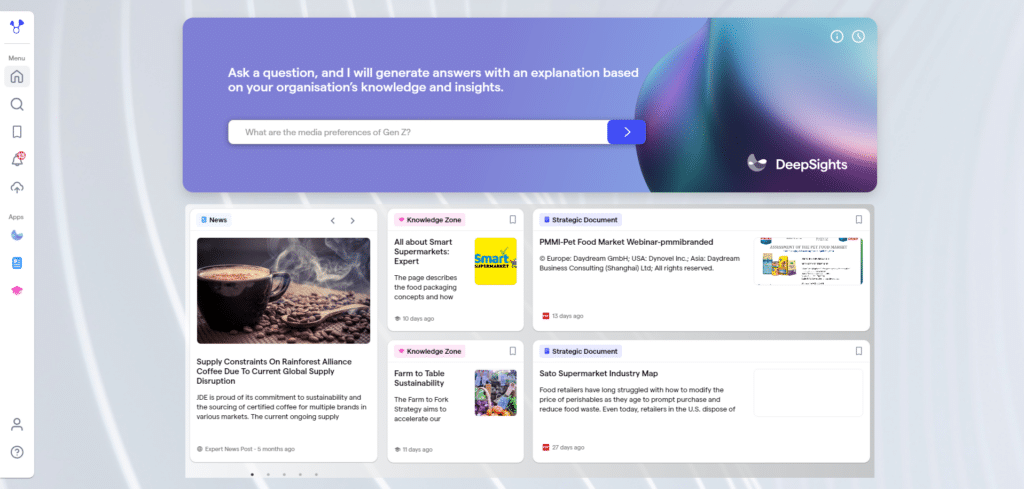
Benefit from an AI-powered insights ecosystem to put critical insights in your decision makers’ direct line-of-sight, at scale, so essential findings don’t go unnoticed. It’s all about transforming the insights function to drive business impact and step into its strategic role.
Also, unlike generalized AI platforms like CoPilot, which may offer unreliable answers because the systems aren’t tailored to understand market research contexts, DeepSights™ uses advanced methods to deliver information that’s highly relevant to the questions you ask, giving you accurate insights you can trust.
Finally, as an end-to-end insights management platform, DeepSights™ provides alignment on knowledge for the entire organization. Only when insights are maintained in a central system and easy to access and retrieve, they are then able to be turned into action.
For more elaborate queries and knowledge sharing, DeepSights™ generates detailed insights reports by synthesizing information across documents while maintaining source attribution.
Watch the discussion on-demand

The invaluable perspectives shared by Elias Soussou, Soumya Nair, Joseph Rini, and Richard Kelly during the TMRE @ Home panel discussion underscore the transformative strategies insights teams can adopt to elevate their impact across their organizations.
From enhancing collaboration in research briefs to leveraging cutting-edge AI for seamless insights management, the strategies discussed are key to translating insights into winning business decisions. Watch the entire discussion on-demand here.
Power an AI-driven insights team with Deepsights™ to fuel strategic decisions
Using AI for research and insights is no longer an option, but it’s essential for insights teams wishing to lead the business with innovation. Insights software leader Market Logic’s DeepsightsTM AI assistant and DeepsightsTM Workspace help you refine the tactical aspects of your insights work so insights teams can pave the way for a more strategic, influential role within your business.
If you are ready to take your insights function to the next level, don’t hesitate to get in touch with our team. Together, we can build a robust AI ecosystem tailored to your needs, and empower your insights team to become an indispensable part of your organization’s success.






